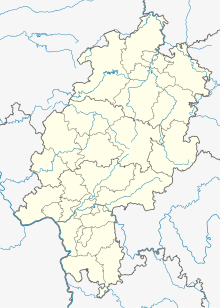Wait for the Landwehr
Coordinates: 51 ° 5 ′ 42 " N , 9 ° 19 ′ 37" E
The waiting room on the Landwehr was a watch tower integrated into the Landwehr of the Landgrave-Hessian Office of Borken opposite the Electoral Mainz city of Fritzlar , not far north of today's Kalbsburg in the north Hessian Schwalm-Eder district . The tower, built in 1431/32 and demolished after 1757, was initially referred to as the "tower on the Bonebach", named after the small settlement of Bunebach or Bonebach.
The 24-meter-high, four-storey late Gothic church tower of the village of Großenenglis about 2 km away , originally the gate tower of the fortified cemetery surrounded by a ring wall , was often incorrectly referred to as the "waiting room for the Landwehr", as it was long known as the "tower on the Bonebach" equated or confused.
history
The cornerstone of the control room was laid by order of Landgrave Ludwig I in September 1431, a few years after the Mainz-Hessian War of 1427, which was victorious for the Landgraviate of Hesse . In addition to monitoring the neighboring Mainz area to the north, the building also served as a place of refuge in the event of danger from marauding robbers, and according to an agreement between the Landgrave and Archbishop of Mainz Konrad III. from 1432, also entitled Mainz subjects. (In return, Hessian subjects were allowed to find refuge in the Fritzlarer Warten near Holzheim and in the Ederaue if necessary.) The waiting room should be open to the Mainz people at all times, but remain closed to their enemies.
Landgraf was waiting with their accessories first one Fischbach and then to Henne Semenbrogke to fief . On February 18, 1448, his grandson, Landgrave Ludwig II , transferred this fiefdom for life to his bailiff Philipp von Borken and his wife Margarethe, so that they should secure and structurally maintain the control room for the benefit of the master, the country and the people. After Philip's death, the fiefdom was transferred to Henne II von Wehren on December 7, 1457 , who had agreed on this with Philip's widow.
On July 11, 1494, Landgrave Wilhelm I gave his Privy Councilor , hereditary kitchen master and bailiff of Borken , Philipp von Wildungen , the tower on the Landwehr with its curtain wall and all accessories as a man's fief and allowed him to erect a building there and "Hoen Englyes ”. This building, the nucleus of the manor known as Kalbsburg from the middle of the 16th century, was not yet completed when Philip died in 1505. The von Wildungen extended the fiefdom with surrounding forests and fields, expanded the estate and remained in the possession of the estate "Hohenengelsüß called the Kalbsburg" until 1596, which Burkhard (Burghard) von Wildungen then pledged to his brother-in-law Melchior von Hanstein . This was followed by numerous changes of ownership through lending and sales of the property, which continued to be used for agriculture until 1956.
The old control room lost its meaning over time. It can still be found on the “Schleenstein map” from 1715 and also on a map from 1757, which deals with border disputes between Kurmainz and the Hessian authorities of Gudensberg and Borken. The control room is no longer recorded on the “Level Map of the Electorate of Hesse” (Borken sheet, 1859) made between 1840 and 1861. It had probably been demolished in the meantime as building material for the extension of the estate.
literature
- Werner Ide: From Adorf to Zwesten: Local history paperback for the Fritzlar-Homberg district. Bernecker, Melsungen, 1972 (pp. 213–215)
- Georg Landau : Contribution to local history. "The Kalbsburg" . In: Journal of the Association for Hessian History and Regional Studies . Old series 8, 1860, (pp. 392–395).
Web links
- "Kalbsburg, Schwalm-Eder district". Historical local dictionary for Hessen. In: Landesgeschichtliches Informationssystem Hessen (LAGIS).
- Map with the location of the control room at HNA RegioWiki
